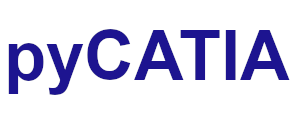pycatia.part_interfaces.sew_surface¶
Module initially auto generated using V5Automation files from CATIA V5 R28 on 2020-06-11 12:40:47.360445
Warning
The notes denoted “CAA V5 Visual Basic Help” are to be used as reference only. They are there as a guide as to how the visual basic / catscript functions work and thus help debugging in pycatia.
- class pycatia.part_interfaces.sew_surface.SewSurface(com_object)¶
Note
CAA V5 Visual Basic Help (2020-06-11 12:40:47.360445)
System.IUnknownSystem.IDispatchSystem.CATBaseUnknownSystem.CATBaseDispatchSystem.AnyObjectMecModInterfaces.ShapePartInterfaces.SurfaceBasedShapeSewSurfaceRepresents the sewing operation.It sews a shape using a sewing element, such as a surface or aface- property deviation: float¶
Note
- CAA V5 Visual Basic Help (2020-07-06 14:02:20.222384)
- o Property Deviation() As doubleSets or Gets the maximum deviation allowed for smoothing operation insewing command. This value must be set in SI unit (m).Example: This example retrieves in DeviationValue the maximum deviationvalue for the Sewfeature.Dim DeviationValue As doubleSet DeviationValue = Sew.MaximumDeviationValue
- Return type:
float
- property deviation_mode: int¶
Note
- CAA V5 Visual Basic Help (2020-07-06 14:02:20.222384)
- o Property DeviationMode() As longReturns or sets the Deviation mode taken into account during Sewconstruction.Legal values:0Unknown Deviation mode.1None Deviation mode. Error thrown if maximum deviation exceeds CATIAresolution.2Automatic Deviation mode. Error thrown if maximum deviation exceeds 100times CATIA resolution.3Manual Deviation mode. Error thrown if maximum deviation exceeds inputuser deviation.Example:This example retrieves in oMode the Deviation mode for the Sewfeature.Dim oModeSet oMode = Sew.DeviationMode
- Return type:
int
- set_surface_support(i_support_surface: Reference) None¶
Note
- CAA V5 Visual Basic Help (2020-07-06 14:02:20.222384))
- o Sub SetSurfaceSupport(Reference iSupportSurface)Sets the surface support for surfacic sew surface.Parameters:iSupportSurfaceA Reference object to a surface (seeReference for more information)
- Parameters:
i_support_surface (Reference) –
- Return type:
None
- set_volume_support(i_volume: Reference) None¶
Note
- CAA V5 Visual Basic Help (2020-07-06 14:02:20.222384))
- o Sub SetVolumeSupport(Reference iVolume)Sets the volume support for volume sew surface.Parameters:iVolumeA Reference object to a volume (seeReference for more information)Example:The following example sets the volume support of SewSurfacefirstSewSurface to volumeExtrude volume reference:firstSewSurface.SetVolumeSupport volumeExtrudeRef
- Parameters:
i_volume (Reference) –
- Return type:
None
- property sewing_intersection_mode: int¶
Note
- CAA V5 Visual Basic Help (2020-07-06 14:02:20.222384)
- o Property SewingIntersectionMode() AsCatSewingIntersectionModeReturns or sets the sewing mode . The sewing side is the side of the bodykept after the sewing. A positive side refers to the same orientation than thesewing element normal vector.Example:The following example returns in sptSide the sewing side of the sewshape mySew, and then sets it to catPositiveSide:Set sptSide = mySew.SewingSidemySew.SewingSide = catPositiveSide
- Returns:
enum cat_sewing_intersection_mode
- Return type:
int
- property sewing_side: int¶
Note
- CAA V5 Visual Basic Help (2020-07-06 14:02:20.222384)
- o Property SewingSide() As CatSplitSideReturns or sets the sewing side . The sewing side is the side of the bodykept after the sewing. A positive side refers to the same orientation than thesewing element normal vector.Example:The following example returns in sptSide the sewing side of the sewshape mySew, and then sets it to catPositiveSide:Set sptSide = mySew.SewingSidemySew.SewingSide = catPositiveSide
- Returns:
enum cat_split_side
- Return type:
int
